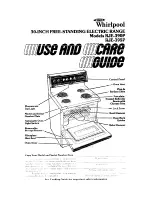
Your wood stove may be hooked up with a 6”
factory-built or masonry chimney. If you are using
a factory-built chimney, it must comply with UL 103
or CSA-B365 standard; therefore it must be a Type
HT (2100°F). It must be installed according to the
manufacturer’s specifications. Take into account
the chimney’s location to ensure it is not too close to
neighbors or in a valley which may cause unhealthy
or nuisance conditions. If you are using a masonry
chimney, it must be built in compliance with the
specifications of the National Building Code. It
must be lined with fire clay bricks, metal or clay
tiles sealed together with fire cement. Round flues
are the most efficient. The interior diameter of the
chimney flue must be identical to the stove smoke
exhaust. A flue which is too small may cause draft
problems, while a large flue favors rapid cooling of
the gas, and hence the build-up of creosote and the
risk of chimney fires. Note that it is the chimney and
not the stove which creates the draft effect; your
stove’s performance is directly dependent on an
adequate draft from your chimney.
Do not connect
this unit to a chimney flue serving another
appliance.
The following recommendations may
be useful for the installation of your chimney:
1.
It must rise above the roof at least 3’ (0.9m) from
the uppermost point of contact.
2. The chimney must exceed any part of the
building or other obstruction within a 10’
(3.04m) distance by a height of 2’ (0.6m).
3. The installation of an interior chimney is always
preferable to an exterior chimney. Indeed, the
interior chimney will, by definition, be hotter
than an exterior chimney, being heated up by
the ambient air in the house. Therefore the
gas which circulates will cool more slowly, thus
reducing the build-up of creosote and the risk
of chimney fires.
4. The draft caused by the tendency for hot air to
rise will be increased with an interior chimney.
5.
Using a fire screen at the extremity of the
chimney requires regular inspection to ensure
that it is not obstructed thus blocking the draft,
and it should be cleaned when used regularly.
FACTORY BUILT CHIMNEY
When a metal prefabricated chimney is used, the
manufacturer’s installation instructions must be
followed. You must also purchase (from the same
manufacturer) and install the ceiling support
package or wall pass-through and “T” section
package, firestops (where needed), insulation
shield, roof flashing, chimney cap, etc. Maintain
proper clearance to the structure as recommended
by the manufacturer. The chimney must be the
required height above the roof or other obstructions
for safety and proper draft operation.
Listed Cap
Maintain 2”
Clearance
Listed
Chimney
Ceiling
Support
Ceiling
Support
Chimney
Connector
*
* Refer to Clearance
to Combustibles
Combustible Wall
Floor
Protector
To Stove
Storm Collar
Flashing
Listed
Chimney
Attic
Insulation
Sheild
Specified
Clearance
Chimney
Connector
Combustible
Ceiling Joists
To Stove
MASONRY CHIMNEY
Ensure that a masonry chimney meets the
minimum standards of the National Fire Protection
Association (NFPA) by having it inspected by a
professional. Make sure there are no cracks, loose
mortar or other signs of deterioration and blockage.
Be sure to the chimney cleaned before the stove is
installed and operated. When connecting the stove
through a combustible wall to a masonry chimney,
special methods are needed.
INSTALLATION
© 2021 United States Stove Company
9










































